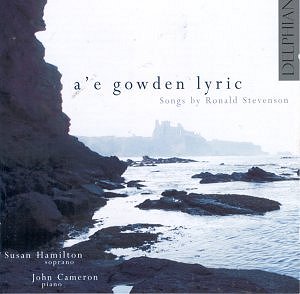Susan Hamilton's voice is of a delightful type. It preserves a quality
that, judging by its minority presence, must be deemed unprized.
I value it highly. Sopranos by the score can produce operatically
effective drama. They are lauded to the sky for clouding the
words with quavering vibrato either adopted for effect or made
inevitable due to vocal fatigue. Such orthodox blowsiness would
kill these songs dead. As it is Hamilton
stands in the select company of Catherine Bott (the hallmark
voice of Swingle II), the young Felicity Palmer and Netania
Davrath. Her voice has a boy treble character but with the depth
that goes with a mature voice. She is perfectly suited to Stevenson's
setting of his namesake's poems in 'A
Child's Garden of Verses'. She sounds as if she sings
as a child but the words and the piano root the music in adult
sensibilities. There is horror here (the unadulterated ghoulishness
of Shadow March and
Windy Nights) but also nature painting as
in Rain. There
is also a magnificence as in Summer
Sun. Stevenson's seventeen songs in A
Child's Garden have a faintly Delian harmonic touch
but they live a life that is ruddy, cheeky, swinging, haunted,
exultant but not cloyed with late romantic afflatus - listen
to Stevenson's way with the words 'Sing a song of seasons' from
Autumn Fires (tr.
14). He has, without doubt, learnt something from Poulenc. I
also fancied parallels with Luening's songs (on Parnassus)
and with Leo Smit's settings of the Emily Dickinson poems (recorded
by Bridge). These songs are vividly imagined and communicated
settings. They track the line between the merely childish and
the childlike vision - that land of lost content - another 'Grand
Meaulnes'. These settings are not for those who can only take
English songs as traded by Warlock, Moeran and Head. The lyrical
tradition may be the same but the development melds in a touch
of dissonance, with voices from Pierrot
Lunaire, Poulenc, Britten and certain Finzi songs
(Channel Firing). The cycle is rounded out
by the song Envoy (at
just over six minutes the longest here) in a chilly yet comforting
glisten as the listener looks out on himself or herself as the
shade of the child he or she once was.
The other songs abandon Englishry and look Northwards in another eighteen
songs to words by Hugh MacDiarmid, William Soutar and Sorley
MacLean. There is a tranced beauty and cradled quality about
so many of these songs as in The
Quiet Comes In (23), The Gaelic Muse (21), The Rose of All the World (tr.33), and Traighean (18) - something grief of the Clearances
and the great emigrations. John Cameron is a constant strength
and both he and Hamilton show their mastery of plastic rhythmic
trickery in The Buckie Braes (22). A braw drama shakes
its way through the quasi-operatic settings of The
Robber (19), The
Droll Wee Man (tr.31 - more humour here though) and
O wha's the bride (tr.26).
There are some gifts of words here - try 'yinceyirn' in Fairytales
(tr.29). The setting of William Soutar's Plum
Tree (decked with bloom before the flowers come 'flichterin'
doun in shoo'rs / like shoo'rs o' snaw') catches a Housman 'Cherry
Tree' moment in a Scots accent but remaining just as poignantly
affecting.
Thank God there is not a trace of whiskey-soused tartanry here. These
songs are national and indeed international treasures. I guarantee
that the title track (the last song here) will have you setting
repeat time after time. I certainly did.
The words of that last lyric may well be Stevenson speaking to us through
MacDiarmid's words:-
Better a'e gowden lyric
Than the castle's soaring waa;
Better a'e gowden lyric
Than onythin' else avaa.
Even so I still make the case for the recording of a number of Stevenson's
'soaring waas' - the concertos for cello and violin as well
as the completion of his grandest tapestry the choral and orchestral
epic Ben Dorain. What an opera Stevenson might
have made of Lewis Grassic Gibbon’s ‘Cloud Howe’ … if only.
Returning to reality … closer in the offing is a recording of
Stevenson’s great set of variations on the magical melody that
sings and surges heart-rendingly from the middle movement of
Arnold Bax's Second Symphony.
Delphian finish this excellent disc with a well rounded introduction by
Colin Scott-Sutherland and by printing the texts in full. Three
small criticisms: non-Scots might have found it helpful to have
a footnote to explain some of the words, dates for the songs
would have been appreciated and the poems in the booklet could
have done with being numbered to match the tracks.
Susan Hamilton's voice is a clarion instrument and so well chosen for
these songs. I hope I will hear more from her .... and soon.
I see that in 1988 Stevenson wrote his May
Songs (soprano and string orchestra) for her. A recording
would surely be welcomed. Similarly it would be good if John
Cameron could be chosen to record Stevenson’s legion of folk-based
piano solos.
This is Editor's disc of the month. This CD will find friends worldwide;
for those who value words, music and in their coupling the power
to move.
Rob Barnett



![]() Susan
Hamilton (soprano)
Susan
Hamilton (soprano) ![]() DELPHIAN DCD 34006 [66.59]
DELPHIAN DCD 34006 [66.59]